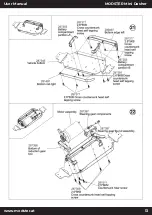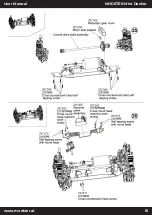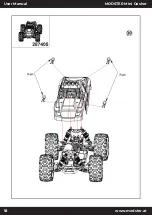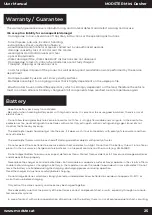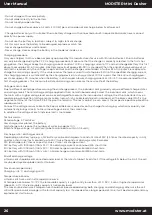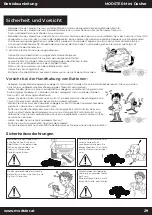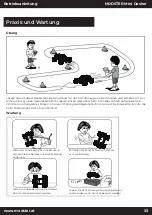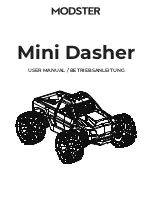
27
User Manual
MODSTER Mini Dasher
www.modster.at
Self-discharge:
Lithium cells have an extremely low self-discharge rate (about 0.2% per day) and therefore can be stored for long periods wit-
hout problems. If the voltage drops below 3 volts/cell, it is essential to recharge. Deep discharge must be avoided, otherwise
the cell will suffer permanent damage in the form of capacity loss and render the battery pack unusable.
Storage:
Before longer storage, the batteries should be charged to the storage voltage of approx. 3.8...3.9 volts/cell. After approx. 3-5
months they should be recharged. Never store or keep fully charged but only fully charge immediately before use. Store bat-
teries in a fireproof lithium safe or tested lithium bag. Store and keep at room temperature (17-22°C).
Lifetime:
The theoretical life of a cell at low discharge currents, is approximately 500 charge/discharge cycles. At medium discharge cur-
rents, the lifetime is lower and is only about 300 cycles. At high discharge currents, the number of cycles is in the range of 150-
200 cycles. At very high discharge currents even significantly lower. After that, the battery is used up and must be disposed of.
If the lithium batteries are only discharged to approx. 70-75% during operation, they will thank you with a longer service life.
Stop operation before a noticeable loss of power becomes apparent. Disconnect the battery from the load after operation to
avoid further discharge.
Memory effect, cell capacity
Since lithium cells have no memory or lazy-battery effect, the discharge-charge (cycling, matching) required for NC and NiMH
batteries is not necessary. Discharging before charging should also be avoided. Since the capacity of the lithium battery de-
creases slightly with each charge, this would cause unnecessary loss of capacity to the cell.
Interconnecting battery packs
Interconnecting lithium cells in series or parallel to increase voltage or capacity is problematic because of the differences in
charge voltage and capacity. Only selected cells can be connected together to form a battery pack. For our lithium battery
packs, only selected cells are connected together to form a battery pack.
Disposal of rechargeable batteries
Never dispose of rechargeable batteries in the household waste. To protect the environment, give defective or used batteries
only discharged to the appropriate collection points. These are all sales points for batteries and rechargeable batteries, or mu-
nicipal special waste collection points. To avoid short circuits, please tape off any bare contacts with adhesive tape.
Disclaimer
Since MODSTER cannot supervise the handling of the batteries, any liability and warranty is excluded.
Summary of Contents for Mini Dasher
Page 1: ...USER MANUAL BETRIEBSANLEITUNG Mini Dasher...
Page 8: ...User Manual 8 MODSTER Mini Dasher www modster at Assembly Exploded Diagram...
Page 9: ...9 User Manual MODSTER Mini Dasher www modster at...
Page 10: ...User Manual 10 MODSTER Mini Dasher www modster at...
Page 11: ...11 User Manual MODSTER Mini Dasher www modster at...
Page 12: ...User Manual 12 MODSTER Mini Dasher www modster at...
Page 13: ...13 User Manual MODSTER Mini Dasher www modster at...
Page 14: ...User Manual 14 MODSTER Mini Dasher www modster at...
Page 15: ...15 User Manual MODSTER Mini Dasher www modster at...
Page 16: ...User Manual 16 MODSTER Mini Dasher www modster at...
Page 17: ...17 User Manual MODSTER Mini Dasher www modster at...
Page 18: ...User Manual 18 MODSTER Mini Dasher www modster at...
Page 37: ......

